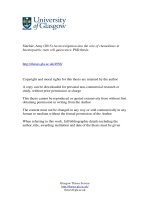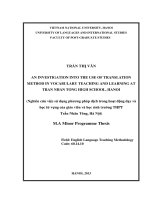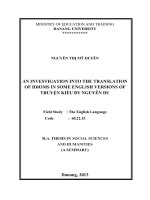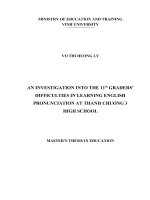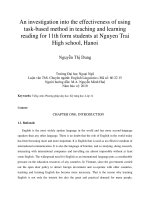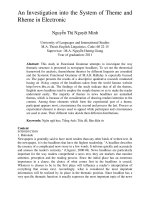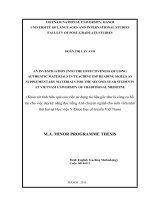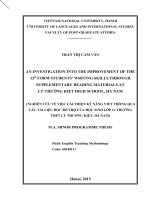An investigation into the translation of idioms in some english versions of truyện kiều by nguyễn du
Bạn đang xem bản rút gọn của tài liệu. Xem và tải ngay bản đầy đủ của tài liệu tại đây (247.2 KB, 26 trang )
MINISTRY OF EDUCATION AND TRAINING
DANANG UNIVERSITY
***********
NGUYỄN THỊ MỸ DUYÊN
AN INVESTIGATION INTO THE TRANSLATION
OF IDIOMS IN SOME ENGLISH VERSIONS OF
TRUYỆN KIỀU BY NGUYỄN DU
Field Study : The English Language
Code : 60.22.15
M.A. THESIS IN SOCIAL SCIENCES
AND HUMANITIES
(A SUMMARY)
Danang, 2013
The study has been completed at
Danang University
Supervisor: Assoc. Prof. Dr. Lưu Quý Khương
Examiner 1: Dr. Ngũ Thiện Hùng
Examiner 2: Assoc. Prof. Dr. Lê Phạm Hoài Hương
This thesis was defended at the Examining Committee at the
University of Danang.
Time : June 08-09, 2013
Venue: Danang University
The original of the thesis is accessible for purpose of reference at:
-The College of Foreign Language Library, Danang University
-The Information Resources Centre, Danang University
1
CHAPTER 1
INTRODUCTION
1.1. RATIONALE
Idioms are considered as the beauty of a language, and
displays identities of culture of a nation. Each idiom has unique
meaning which is not derived from the meanings of each individual
word. Therefore, idioms are used in literary works to make language
more metaphoric and deeply imbued with its national identity.
Truyện Kiều by Nguyễn Du is considered one of the great
works with a large number of idioms. According to my statistics,
Nguyễn Du used about 200 idioms in Truyện Kiều. For example, to
describe the misery of Kiều and the boredom in her life when being
forced to become a prostitute in “the house of mirth”, he wrote:
(1) “Mặt sao dày gió dạn sương
Thân sao bướm chán ong chường bấy thân?” [36, p. 471]
In this verse, the two idioms are continuously used: “dày gió
dạn sương” and “bướm chán ong chường”.
There are also many other idioms such as "ăn xổi, ở thì" in
"Phải điều ăn xổi, ở thì”; "cá chậu, chim lồng" in "Bõ chi cá chậu,
chim lồng mà chơi”; or “Trong ấm, ngoài êm” in “Sao cho trong
ấm thì ngoài mới êm” and so on.
All these idioms are skillfully utilized in different ways by
Nguyễn Du, which contributes to making Truyện Kiều a masterpiece
all over the world.
2
However, when translating these idioms into English,
translators might face many problems. The biggest problem is that
some translators do not fully understand the intention of the writer.
Nor do they find a corresponding expression or translation equivalent
in English. Look at the following translation of some lines quoted
from Truyện Kiều:
(2) Bấy lâu đáy bể mò kim [36, P.541]
Yet I, too, groping for lost jade beneath the tide
[33, p.165]
According to Đào Duy Anh [36, p.111], “đáy bể mò kim” or
“mò kim đáy bể” means “it is extremely difficult to grope for a
needle at the bottom of the sea, but people try to look for it.”. Thus,
this idiom refers to an extremely difficult task to accomplish, and the
word “kim” in (4) should be literally translated into “needle”.
However, in English version, the translator used the word “jade” to
substitute for it. It is clear that there was a mistake in English
version. It seems that the translator misunderstood the word “kim” –
a small instrument of steel used in sewing with the word “kim” in the
Sino-Vietnamese phrase “kim-thạch” which means gold – a valuable
and precious metal.
In general, in translating idioms, translators meet various
difficulties that are not easy to overcome, especially translating the
ones in poetry. Therefore, the thesis: “An Investigation into the
Translation of Idioms in Some English Versions of Truyện Kiều
by Nguyễn Du” was carried out to find out how they were
3
transferred into English as well as the most effective and frequently
used procedures in the translation. As a result, the study can help the
foreign readers better understand the idioms in Truyện Kiều.
Furthermore, it will help the translators and learners of English know
how to use procedures of idiom translation in the best way.
1.2. AIMS AND OBJECTIVES
1.2.1. Aims
- To investigate the translation of idioms in Truyện Kiều into
English as manifested in their different English versions by
Vietnamese and Australian translators in terms of syntax and
semantics to identify the similarities and differences between the two
versions as well as to generalize the effective ways to render these
idioms.
1.2.2. Objectives:
- To examine the translation equivalence of idioms in Truyện
Kiều in the English versions in terms of syntax and semantics.
- To identify the similarities and differences in the
translation of idioms in Truyện Kiều between different English
versions.
- To discuss the effectiveness of translation of idioms in the
English versions of Truyện Kiều.
- To give out some recommendations in the rendering of
idioms from Vietnamese into English.
1.3. RESEARCH QUESTIONS:
4
1. How are the syntactic features of idioms in Truyện Kiều
transferred to English as manifested in its English versions?
2. How are the semantic features of idioms in Truyện Kiều
transferred to English as manifested in its English versions?
1.4. SCOPE OF THE STUDY:
The research will focus on the investigation into the
translation of the syntactic and semantic features of idioms in Truyện
Kiều as well as the translation procedures manifested in its English
versions: The Tale of Kiều - a highly appreciated version by Huỳnh
Sanh Thông (1983) – a Vietnamese translator and The Kim Vân Kiều
by Vladislav Zhukov (2004) – an Australian translator.
1.5. ORGANIZATION OF THE STUDY
The research includes five chapters as follows:
Chapter 1: “Introduction
Chapter 2: “Literature Review and Theoretical Background”
Chapter 3: “Research Design and Methodology”
Chapter 4: “Findings and Discussion”
Chapter 5: “Conclusion and Recommendation”
CHAPTER 2
LITERATURE REVIEW
AND THEORETICAL BACKGROUND
2.1. AN OVERVIEW TO THE PREVIOUS STUDIES
RELATED TO THE RESEARCH
So far there have been a lot of researches on translation of
Truyện Kiều by linguists, language teachers and students. Phạm Thị
5
Ngọc Mến [20] investigated the syntactic, semantic features and
stylistic means of euphemisms in the story of Kiều and their
equivalents in English versions. She compared and contrasted
Truyện Kiều with the three English versions to find out the best way
to translate euphemisms into English. Hoàng Trương Phước Lộc [18]
investigated the translation of hyperboles from Vietnamese into
English as manifested in the English versions of Truyện Kiều to
identify the similarities and differences between the two versions as
well as to generalize the effective way to render this stylistic device.
Võ Thị Bích Liên [17] investigated expressions describing the
villians in Kiều’s Story and their English translational equivalents in
terms of lexical and semantic aspects. She compared and contrasted
Truyện Kiều with the three English versions to find out the
effectiveness of translation of expressions describing the villians in
Kiều’s Story in English.
2.2. THEORETICAL BACKGROUND
2.2.1. Theories of Translation
a. Definition of Translation
Newmark [22, p.17] pointed out: “translation is a craft
consisting in the attempt to replace a written message and/ or
statement in another language”. Moreover, he presents further view
towards transferring meaning in a translation. He said [23, p.5],
“Translation is rendering the meaning of one text into another
language in the way that the author meant the text”.
b. Translation Equivalence
6
Translational equivalence is the similarity between a word
(or expression) in one language and its translation in another. This
similarity results from overlapping ranges of reference. [72]
c) Poetry Translation
On the various methods employed by English translators,
Lefevere catalogues seven different procedures of poetry translation
[3, p.81-82]: Phonemic translation, Literal translation, Metrical
translation, Poetry into prose, Rhymed translation, Blank Verse
Translation and Interpretation
d) Translation Methods
According to Vinay and Darbelnet [32, p.84], translators can
choose from two methods of translating, namely direct, or literal
translation and oblique translation.
However, according to Newmark [22, p.81], there are eight
methods of translation: Word-for-word translation, Literal
translation, Faithful translation, Semantic translation, Adaptation,
Free translation, Idiomatic translation, Communicative translation.
e) Translation Procedures
At the syntactic level, Catford [5], suggested two main types
of translation shifts, namely level shifts, where the SL item at one
linguistic level (e.g. grammar) has a TL equivalent at a different
level (e.g. lexis), and category shifts which are divided into four
types: Structural shifts, Class shifts, Unit shifts or rank shifts, Intra-
system shifts.
7
At the semantic level, Newmark [23] proposed different
translation procedures as follows: Literal translation, Transference,
Naturalization, Cultural equivalent, Functional equivalent,
Descriptive equivalent, Componential analysis, Synonym, Through-
translation, Shifts or transpositions, Modulation, Recognized
translation, Compensation, Paraphrase, Reduction and Expansion,
Couplets.
2.2.2. Idioms
a) Definition of Idioms
According to Hornby [28], idiom was defined as “a group of
words whose meaning is different from the meaning of the individual
words.”
b) Main Features of Idioms
- Structural Features
Idioms in both English and Vietnamese are structurally
and lexically closely combined phrase. It means that the stability in
idioms is very high. An idiom allows no variation in form under
normal circumstances.
- Semantic Features
Semantic opacity or non-literalness can perhaps be considered
as the most frequently mentioned feature of idioms. It means that
idioms are often nonliteral, which is why their meanings cannot be
deducted from the meanings of the individual words of the idiom.
c) The Difficulties in Translating Idioms
8
Using idioms is very much a matter of style, and
translating idioms from one language to another is very difficult
because there are a lot of differences in rhetorical effect of using
idioms. Therefore, it requires a translator to be not only accurate but
highly sensitive to the rhetorical nuances of the language.
2.2.3. Nguyễn Du
Nguyễn Du (1766-1820) (pennames Tố Như and Thanh Hiên)
was born in Tiên Điền village, Nghi Xuân district, Hà Tĩnh province,
Vietnam. He was descended from a noble mandarin family. He was a
great poet in the late eighteenth and early nineteenth century. In
addition to Truyện Kiều, his masterpiece, he left to Vietnamese
literature numerous poetic works in both Chữ Nôm and Chinese such
as “Văn Tế Thập Loại Chúng Sinh”, “Văn Tế Sống Trường Lưu Nhị
Nữ”, “Thác Lời Trai Phường Nón”,“Bắc Hành Tạp Lục”, “Nam
Trung Tạp Ngâm”, “Thanh Hiên Thi Tập”. Nguyễn Du was awarded
the title “Cultural World Person” by the UNESCO in 1965.
2.2.4. Truyện Kiều and Its English Versions
Truyện Kiều, which was based on an earlier Chinese work
known as Kim Vân Kiều and was originally titled Đoạn Trường Tân
Thanh, is an epic poem in Vietnamese written by Nguyễn Du at
about the end of the 18th century. It is widely regarded as the most
significant work of Vietnamese literature. In 3,254 verses, the poem
was written in: “lục bát” meter – a strict form consisting of
alternating lines of six words followed by eight ones.
9
So far, there have been 7 English versions of Truyện Kiều
including Kim Van Kieu by Lê Xuân Thủy (1968), The Tale of Kiều
by Huỳnh Sanh Thông (1983), Kiều by Michael Councell (1995),
The Story of Kiều by Lê Cao Phan (1996), Kiều by Hoài Văn Tử
(1996), The Kim Van Kieu by Vladislav Zhukov (2004), and the
latest version: Kieu (an English version adapted from Nguyen Khac
Vien's French Translation) by Arno Abbey (2008).
2.3. SUMMARY
CHAPTER 3
RESEARCH DESIGN AND METHODOLOGY
3.1. RESEARCH METHODS:
The study is carried out with the combination of both
descriptive method and contrastive method. In addition, the study
will be carried out by the combination of some other methods such as
statistic method, synthetic method and so on.
3.2. SAMPLING
- Idioms in Truyện Kiều and their translation equivalents in
the English versions by Huỳnh Sanh Thông (1983) and Zhukov
(2004).
- 200 samples in Truyện Kiều, 200 samples in The Tale of
Kiều by Huỳnh Sanh Thông and 200 samples in The Kim Vân Kiều
by Vladislav Zhukov.
3.3. DATA COLLECTION
3.4. DATA ANALYSIS
10
3.5. RESEARCH PROCEDURES:
3.6. RELIABILITY AND VALIDITY
3.7. SUMMARY
CHAPTER 4
FINDINGS AND DISCUSSION
4.1. THE TRANSLATION OF THE SYNTACTIC FEATURES OF
IDIOMS IN TRUYệN KIềU FROM VIETNAMESE INTO ENGLISH
4.1.1. The Translation of the Syntactic Features of Idioms
in Truyện Kiều in the English Version by Huỳnh Sanh Thông
a) Structure- shifts
(1) Lần thâu gió mát trăng thanh [35, p. 505]
Cool breeze, clear moon - her nights were going round. [30, p.113]
Structure shifts
N+Adj
àAdj + N:
gió mát trăng thanh
N Adj N Adj
Cool breeze, clear moon
Adj N Adj N
b) Class shifts
(2) Buồng không lặng ngắt như tờ [35, p.427]
A death-still silence filled the void, her room. [30, p. 5]
Class shifts
AdjP à NP
lặng ngắt như tờ
Adj như N
A death-still silence
Det Adj N
11
c) Unit-shifts
(3) Ở đây tai vách mạch dừng [35, p.490]
Beware – around here walls have ears and eyes. [30, p.91]
Unit- shifts
NP à Clause
tai vách mạch dừng
NP NP
walls have ears and eyes
S V O
d) Intra-system shifts
(4) Con ong cái kiến kêu gì được oan? [35, p.490]
When wronged, can flies and ants demand redress? [30, p.91]
Table 4.1: Vietnamese singular nouns were changed into
English plural nouns in Huỳnh Sanh Thông’s Version
Vietnamese Singular Nouns English Plural Nouns
con ong flies
cái kiến ants
e) Frequency of Syntactic Translation Procedures
Table 4.2: Occurrence Frequency of syntactic translation procedures
by Huỳnh Sanh Thông
PROCEDURES OCCURENCES %
Structure- shifts 85 42.5
Class-shifts 42 21
Unit-shifts 65 32.5
Intra-system-shifts 8 4
Total 200 100
12
4.1.2. The Translation of the Syntactic Features of Idioms
in Truyện Kiều in the English Version by Zhukov
a) Structure- shifts
(5) Bấy lâu đáy bể mò kim [35, p.541]
Yes I, too, groping for lost jade beneath the tide. [33, p.165]
Structure shifts
A+V+O
à V+O+A
đáy bể mò kim
A V O
groping for lost jade beneath the tide
V O A
b) Class shifts
This procedure appears 44 times accounting for 22% of the
total procedures.
(6) Dặm ngàn, nước thẳm, non xa [35, p.472]
But oh! a thousand li beyond these strangers’ hills. [33, p.66]
Class shifts
NP à Prep P
nước thẳm, non xa
N Adj N Adj
beyond these strangers’ hills
Prep Det Gen N
c) Unit-shifts
(7) Sinh rằng: Gió mát trăng trong [35, p.442]
Yet Kim still sighs: The breeze blows fresh, the moon glows sheer.
Unit- shifts
NP à Clause
Gió mát trăng trong
N Adj N Adj
The breeze blows fresh, the moon glows sheer
S V A S V A
13
d) Intra-system shifts
(8) Miệng hùm nọc rắn ở đâu chốn này! [35, p.500]
Now glitter tiger-fangs, the crypts of serpent-lairs grape
everywhere. [33, p.107]
Table 4.3: Vietnamese singular nouns were changed into
English plural nouns in Zhukov’s Version
Vietnamese Singular Nouns English Plural Nouns
miệng hùm tiger-fangs
nọc rắn the crypts of serpent-lairs
e) Frequency of Syntactic Translation Procedures
Table 4.4: Occurrence Frequency of Syntactic Translation
Procedures by Zhukov
PROCEDURES OCCURENCES %
Structure- shifts 98 49
Class-shifts 44 22
Unit-shifts 50 25
Intra-system-shifts 8 4
Total 200 100
4.1.3. Summary
4.2. SIMILARITIES AND DIFFERENCES IN TERMS OF
SYNTAX BETWEEN THE TWO TRANSLATIONS
Table 4.5: The Frequency of Syntactic Translation Procedures Used
by Huỳnh Sanh Thông and by Zhukov
14
PROCEDURES HUỲNH SANH THÔNG ZHUKOV
Structure- shifts 42.5% 49%
Unit-shifts 32.5% 25%
Class-shifts 21% 22%
Intra-system-shifts 4% 4%
4.2.1. Similarities
4.2.2. Differences
4.3. The Translation Of The Semantic Features Of Idioms In
Truyện Kiều From Vietnamese Into English
4.3.1. The Translation of the Semantic Features of Idioms
in Truyện Kiều in the English Version by Huỳnh Sanh Thông
a) Literal Translation
(9) Mạt cưa mướp đắng đôi bên một phường [35, p.455]
Sawdust and bitter melon met and merged. [30, p.43]
In (9), the idiom “Mạt cưa mướp đắng” was used to refer to
the pair: Mã Giám Sinh and Tú Bà who were considered as well-
matched swindlers. This idiom was literally translated into English.
Source Text Literal Translation
mạt cưa sawdust
mướp đắng bitter melon
b) Reduction
(10) Mà trong nham hiểm giết người không dao [35, p.492]
The heart will scheme to kill without a knife. [30, p. 95]
This diom was used to refer to the cruelty and malignance of
Hoạn Thư to Kiều. It can be easily recognized that the object người
15
was omitted in the English version. Perhaps, the translator thought
that the readers could understand his implication through the context
without it.
Source Text giết người không dao
Target Text to kill without a knife
Reduction người
c) Expansion
(11) Xưa nay nhân định thắng thiên cũng nhiều [35, p.440]
Man’s will has often vanquished Heaven’s whim. [30, p.23]
It is obvious that there is a difference between the
Vietnamese idiom and its English equivalent. By the expansion
procedure, the noun whim which means “a sudden idea” was added
in the English version to make the meaning of the idiom clearer.
Source Text nhân định thắng thiên
Target Text Man’s will has often vanquished Heaven’s whim
Expansion
Whim
d) Paraphrase
(12) Mà lòng trọng nghĩa khinh tài xiết bao! [35, p.436]
That in your scale what’s right weighs more than gold. [30, p.17]
In this example, the translator explained the word nghĩa in
Vietnamese by using the phrase “what’s right” and the word tài by
using the word “gold”, which implicates “wealth”. In addition, the
translator used the verbs weighs and the comparative structure to
express the verbs trọng, khinh. Here both denotative meaning and
16
connotative meaning of the Vietnamese idiom were transferred into
English by the procedure paraphrase.
e) Cultural Equivalent
(13) Buồng không lặng ngắt như tờ [35, p.427]
A death-still silence filled the void, her room. [30, p. 5]
In Vietnamese, the idiom lặng ngắt như tờ, which has the
literal translation: as silent as a temple, means “very silent”.
According to Đào Duy Anh [35, p.349], the word tờ is derived from
the word “từ” which means a temple. Obviously, there is a cultural
substitution in the example above. The Vietnamese often compare
silence with a temple while the western compare silence with death.
For example, we often see the idiom silent as the dead in English
which means completely silent. Therefore, the translator used a
death-still silence instead of as silent as a temple in his translation to
make the western readers easier to understand the original idiom.
f) Occurrence Frequency of Semantic Translation Procedures
Table 4.6: Occurrence Frequency of Semantic Translation
Procedures by Huỳnh Sanh Thông
PROCEDURE OCCURENCES %
Literal translation 71 35.5
Reduction 10 5
Expansion 23 11.5
Paraphrase 85 42.5
Cultural equivalent 11 5.5
Total 200 100
17
4.3.2. The Translation of the Semantic Features of Idioms
in Truyện Kiều in the English Version by Zhukov
a) Literal Translation
(14) Trót vì tay đã nhúng chàm [35, p.477]
Yet hands in indigo once dipped come forth not fair. [33, p. 59]
Chàm, a substance from the indigo plant, is a fast dye which
does not dissolve in water and which is not easy to wash or scrub away.
Therefore, tay đã nhúng chàm means that one has made a mistake that
is difficult or impossible to correct. This idiom was literally translated
into English as follows: hands in indigo once dipped. Obviously, this
English equivalent seems to be difficult to understand for those who do
not know the features of indigo. Therefore, it would be better if the
translator added a footnote in his translation
Source Text Literal Translation
tay hands
đã once
nhúng dipped
chàm in indigo
b) Reduction
(15) Cùng chàng kết tóc xe tơ những ngày [35, p.482]
Where he had braided locks with Hoan: whom folk thought
amiable, they said. [33, p.73]
In(15), the phrase kết tóc comes from Sino-Vietnamese “kết
phát” or “kết phát vi phu phụ”. It means that boys and girls are old
enough to get married [35, p.180]. And the phrase xe tơ comes from
18
a classical reference in China. This classical reference talked about
the Old Man of the Moon or the Marriage God (ông tơ in
Vietnamese) who used the red threads to unite those who had been
destined for marrying each other. Hence, both the phrases kết tóc
and xe tơ mean “to get married”. As a result, the translator omissed
the phrase xe tơ in his translation.
Source Text kết tóc xe tơ
Target Text braided locks
Reduction
xe tơ
c) Expansion
(16) Bõ chi cá chậu, chim lồng mà chơi! [35, p.506]
Trail here, and must thy compass know but cage-birds, poor tame
fish in tanks?
In contrast to cá nước chim trời, the idiom cá chậu, chim
lồng refers to the cramp or the confinement. In English version, the
phrase cage-birds, poor tame fish in tanks is the English equivalent
of the Vietnamese idiom. We can see that the phrase poor tame
which shows the regrettable attitude of the author was added in
English version by the procedure expansion.
Source Text cá chậu, chim lồng
Target Text cage-birds, poor tame fish in tanks
Expansion poor tame
d) Paraphrase
(17) Hoạn Thư hồn lạc phách xiêu [35, p.512]
Hoan - wilted, dwindled, wan, her last conceits laid low. [33, p.17]
19
The translator explained the Vietnamese idiom hồn lạc
phách xiêu which refers to the fright of Hoạn Thư by using a series
of past participles and adjective describing her frightened appearance
such as wilted, dwindled, wan. In addition, he used the clause“her
last conceits laid low” to strengthen the meaning of the Vietnamese
idiom. Here the denotative meaning of the Vietnamese idiom and its
English equivalent is different but their connotative meaning is
nearly the same.
e) Cultural equivalent
(18) Chước đâu rẽ thúy chia uyên [35, p.495]
More prone to part kingfishers, mandarin-mate lives? [33, p.99]
According to Nguyễn Thạch Giang [48, p.154], thúy or phi
thúy is a halcyon, and uyên or chim uyên ương (in which uyên is
the male, and ương is the female) is the mandarin duck. The halcyon
and the mandarin duck are the species whose males and females
always live in pairs, never separated from each other. They are
regarded as a symbol of conjugal affection and fidelity. In English
version, thúy was replaced by kingfishers, which has the back
translation: chim bói cá. It is clear that there was a change in lexicon
in English version. In other word, there was a cultural substitution in
translation. In the western culture, kingfishers are monogamous and
pair for life [75]. Therefore, they are also considered as a symbol of
conjugal affection and fidelity. Furthermore, Zhukov was born and
grew up in Australia where many kingfishers are found. As a result,
20
he used the cultural equivalent in his translation to make western
readers easier to understand the implication of the Vietnamese idiom.
f) Frequency of Semantic Translation Procedures
Table 4.7: Occurence Frequency of Semantic Translation
Procedures by Zhukov
PROCEDURE OCCURENCES %
Literal translation 62 31
Reduction 12 6
Expansion 17 8.5
Paraphrase 97 48.5
Cultural equivalent 12 6
Total 200 100
4.3.3. Summary
4.4. SIMILARITIES AND DIFFERENCES IN TERMS OF
SEMANTICS BETWEEN THE TWO TRANSLATIONS
Table 4.8 The Occurrence Frequency of Semantic Translation
Procedures used by Huỳnh Sanh Thông and by Zhukov
HUỲNH SANH THÔNG ZHUKOV
Procedure % Procedure %
Paraphrase 42.5 Paraphrase 48.5
Literal Translation 35.5 Literal Translation 31
Expansion 11.5 Expansion 8.5
Cultural Equivalent 5.5 Cultural Equivalent 6
Reduction 5 Reduction 6
21
4.4.1. Similarities:
4.4.2. Differences
4.5. SUMMARY OF CHAPTER 4
CHAPTER 5
CONCLUSIONS AND IMPLICATIONS
5.1. CONCLUSIONS
The aim of this study was to investigate the translation of
idioms in two English versions of Truyện Kiều by Nguyễn Du in
terms of syntax and semantics. By doing this, we aim to find out the
similarities and differences between the two versions as well as to
generalize the effective ways to render these idioms. After examining
and analyzing 600 samples including 200 Vietnamese idioms in
Truyện Kiều and 400 English translation equivalents in two English
versions by Huỳnh Sanh Thông and Vladislav Zhukov, we can come
to the following conclusions:
Firstly, in terms of syntax, the most frequently used
procedures in both translations were Structure- shifts, Class-shifts
and Unit-shifts with 96% of the total in both English versions. The
least used procedure was Intra-system-shifts with only 4% of the
total. In other words, both translators tended to use Structure- shifts,
Class-shifts and Unit-shifts, and avoid Intra-system-shifts in
translating the syntactic features of idioms.
Secondly, in terms of semantics, the most frequently used
procedures in both translations were Paraphrase and Literal
Translation reaching to 78% of the total procedures applied in the
translation by Huỳnh Sanh Thông and 79.5% in the translation by
22
Zhukov. The least used procedures were Expansion, Reduction and
Cultural Equivalent with only 22% of the total procedures applied
in the translation by Huỳnh Sanh Thông and 20.5% in the translation
by Zhukov. Thus, both translators tended to use Paraphrase and
Literal Translation and tried to avoid Expansion, Reduction and
Cultural Equivalent in their translations.
Thirdly, it can be concluded from the findings that the best
procedures applied in translating idioms in Truyện Kiều in particular
and in poems in general are Structure- shifts, Class-shifts and Unit-
shifts in translating the syntactic features of idioms and paraphrase
and literal translation in translating the semantic features of idioms.
Fourthly, although many scholars do not recommend
translating idioms literally and consider it an inacceptable procedure
because it destroys the meaning of the original expressions and
results in complete nonsense in the TL, most of the literally
translated idioms in Huỳnh Sanh Thông’s version in this study were
entirely understandable to target readers. This implies that literal
translation is by no means a failed procedure in translating idioms.
With this procedure, the translator can keep not only the aesthetic
value but also the cultural value of the original version.
Last but not least, the corpus of idioms collected in Truyện
Kiều and their English equivalents is a valuable source of material
for not only translators, teachers and learners of English, but also for
readers and those who are interested in Truyện Kiều by Nguyễn Du.
23
5.2. IMPLICATIONS
5.2.1. Implications on Translation Work
Firstly, most of idioms are culture-specific, which may cause
many problems for the translators. Therefore, in order to transfer a
source idiom into the target language, the translator must have a
good knowledge of the culture, custom and characteristics of the
places where source language is formed and used. Simultaneously,
s/he also chooses the most appropriate strategies for her/his
translation.
Secondly, translators may use the procedure literal
translation in translating idioms. However, this procedure should
not be applied extensively, but should be used if it secures referential
and pragmatic equivalence to the original, or used with a list of notes
or footnotes and with careful consideration.
Thirdly, translation of idioms in poetry is one of the most
difficult and challenging tasks for every translator. The task of a
translator is to make an art from art, keeping the aesthetic value of
the work. From this, when transferring idioms in poems, it is
important for a translator to have the knowledge of not only idioms
but also poetry so that s/he can reproduce the precise contextual
meaning of the original as well as maintain the rhythm and metre of
the verses.
5.2.2. Implications on the Language Teaching and
Learning
